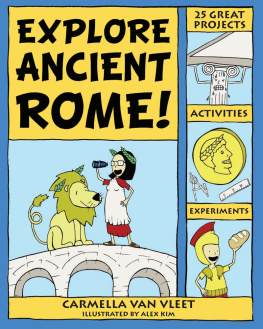

Image Credits
pg..
Nomad Press
A division of Nomad Communications
10 9 8 7 6 5 4 3 2 1
Copyright 2006 by Nomad Press
All rights reserved.
No part of this book may be reproduced in any form without permission in writing from the publisher, except by a reviewer who may quote brief passages in a review. The trademark Nomad Press and the Nomad Press logo are trademarks of Nomad Communications, Inc. Printed in the United States.
ISBN: 0978503775
Questions regarding the ordering of this book should be addressed to
Independent Publishers Group
814 N. Franklin St.
Chicago, IL 60610
www.ipgbook.com
Nomad Press
2456 Christian St.
White River Junction, VT 05001
www.nomadpress.net
Table of Contents


Timeline
of Ancient Egypts History
Most experts like to break up ancient Egypts history into the following time periods:


- Early Dynastic Period, c. 3100-2686 BCE
- Menes, the first Egyptian pharaoh, unites Upper and Lower Egypt. He establishes the capital at what was later known as Memphis.
- Hieroglyphic script is developed.

- Old Kingdom, c. 2686-2181 BCE
- The pharaohs are like god-kings and become very powerful, building many pyramids.
- Irrigation of the Nile River allows the Egyptians to grow more food and Egypts population increases.
- King Khufu builds the Great Pyramid of Giza and the Great Sphinx.

- First Intermediate Period, c. 2181-2055 BCE
- The pharaohs lose power and Egypt splits apart and enters a chaotic time.
- No pyramids are built.

- Middle Kingdom, c. 2055-1650 BCE
- The pharaohs become powerful again and reunite Egypt.
- The Egyptians take control of Nubia, which has valuable resources like gold and semi-precious stones.
- The last pyramids are built.

- Second Intermediate Period, c. 1650-1550 BCE
- Asian invaders take over northeastern Egypt.

- New Kingdom, c. 1550-1069 BCE
- The pharaohs reunite Egypt again and queens are more powerful than before. Some queens become pharaohs.
- Trade with Asia grows.
- Many great temples are built.
- The most famous pharaoh, King Tutankhamen, rules from 1336 to 1327 BCE.

- Third Intermediate Period, c. 1069-644 BCE
- Egypt falls apart and the Nubians in the south regain their independence.
- Many cities are developed.
- Foreigners invade and take over Egypt, first the Nubians in 728 BCE, then the Assyrians, from Mesopotamia (now modern Iraq), in 669 BCE.

- Late Period, c. 644-332 BCE
- The Persians, from the Near East (now Syria, Jordan, Lebanon, and Israel), conquer Egypt in 525 BCE.
- Demotic script is developed.

- Greek & Roman Egypt, c. 322 BCE-639 CE
- Alexander the Great, from Macedonia (north of Greece), conquers Egypt with a Greek army in 332 BCE.
- The Greeks rule Egypt starting in 323 BCE, bringing Greek culture and language to Egypt.
- The Rosetta stone is carved in 196 BCE.
- Cleopatra, the last Greek pharaoh, dies in 30 BCE.
- Augustus, the emperor of the Roman Empire, conquers Egypt. The Romans rule Egypt for more than 600 years.
BCE stands for Before the Common Era and means the same as BC (which stands for Before Christ).
CE stands for Common Era and means the same as AD (or anno Domini).

Introduction
H ave you ever looked at a picture of a pyramid, a mummy, or an ancient clay pot with hieroglyphs and wondered who made it? Or have you ever been to a museum and seen a statue of a pharaoh or an Egyptian peasant and been curious about who these people were and what their lives were like thousands of years ago?
Ancient Egypt existed from about 3100 BCE to about 639 CE, and it was one of the most powerful civilizations of all time. For reasons that we will explore in this book, ancient Egyptian people, thought, and culture have always fascinated the modern world. What was it about these things that made this civilization so strong?


Words to Know
pyramid: monuments that house the tombs of ancient Egyptian pharaohs, as well as all the things he needed in the afterlife. There were three types of pyramids built in ancient Egypt: step pyramids, bent pyramids, and true pyramids.
hieroglyphs: the pictures and symbols that made up ancient Egypts earliest form of writing. Hieroglyphs means sacred writing, and often covered coffins and the walls of tombs and temples.
pharaoh: the ancient Egyptian name for a king.
Centuries and centuries after the last pharaoh died, tourists continue to travel by the thousands to the ancient pyramids, and all over the world people line up for hours at museums and galleries to view exhibits of ancient Egyptian art, architecture, and other relics that shed light on ancient Egyptian life and times.
Because Egypts dry desert sands naturally preserved many tombs, temples, and artifacts, we know a good deal about ancient Egypt and its people. It would be nearly impossible for one book to cover everything about this civilization, but this book will help you understand what life Was like for its people. It explores what ancient Egyptians ate and wore, where they lived and what tools they used, and it also investigates the often mysterious subjects of pharaohs, pyramids, mummies, and tombs.
Next page





























